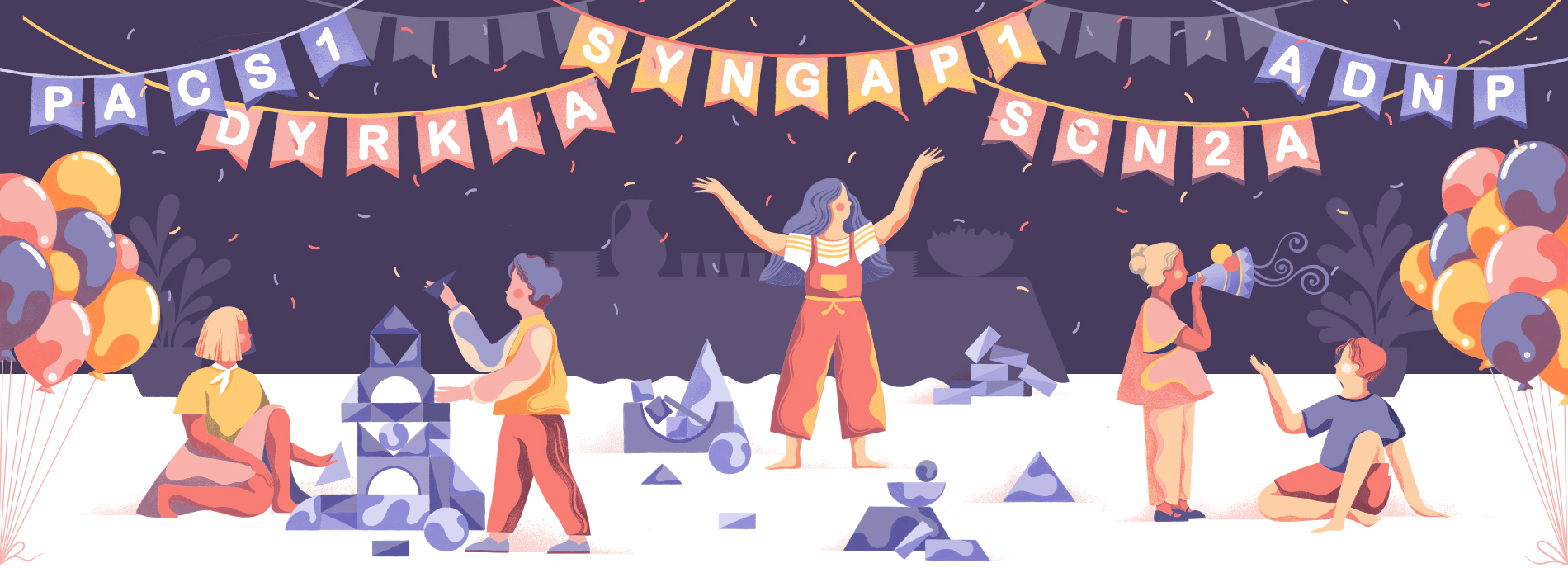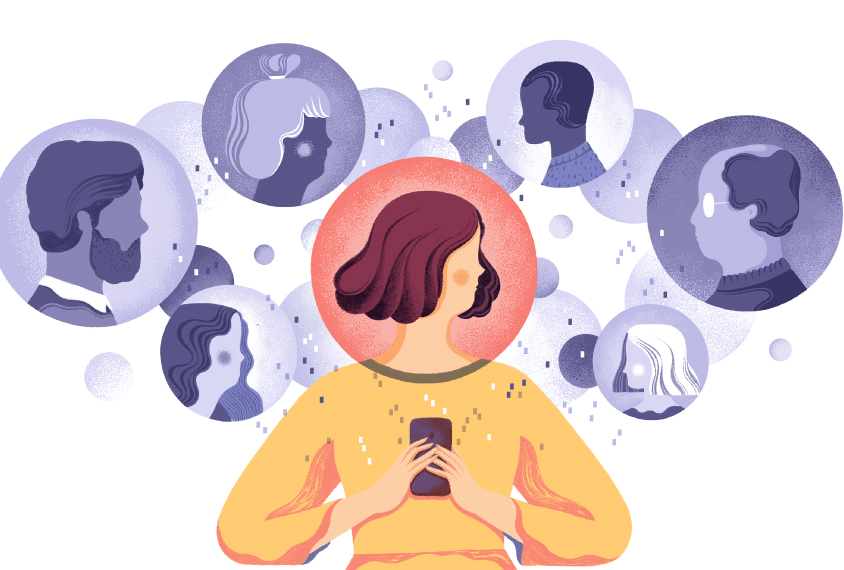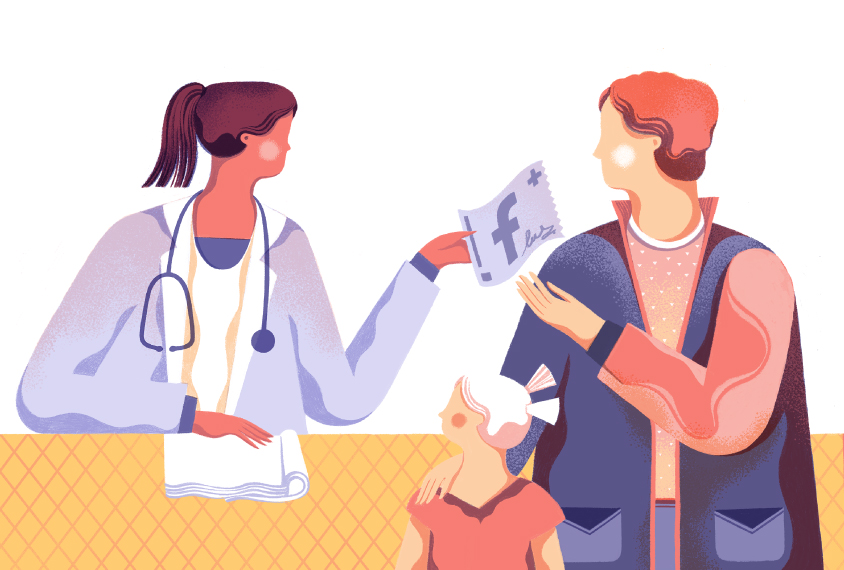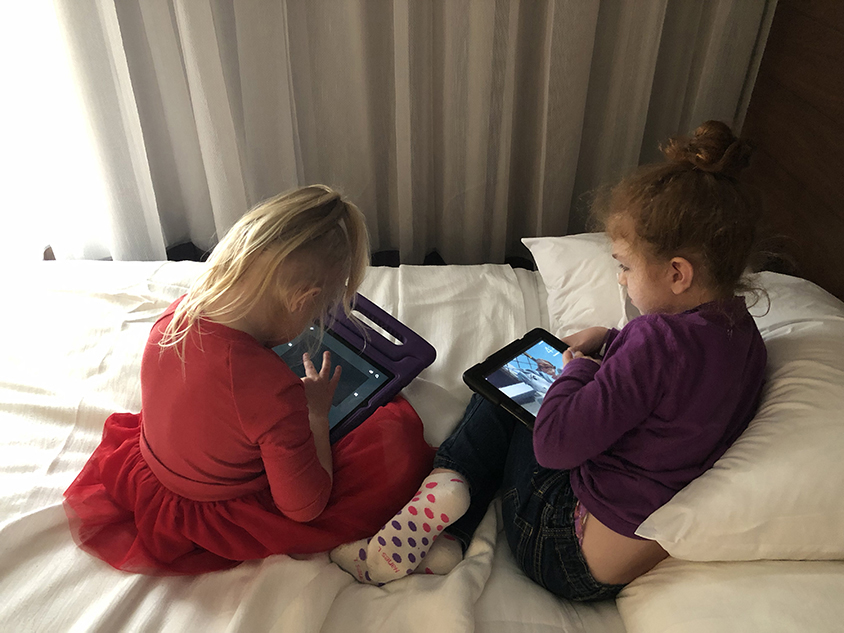
How families are driving the study of autism genes
Parents of children with rare autism-linked mutations are banding together for support and to join forces with scientists, accelerating the pace of research.
I
t looks at first glance like any other Friday at Legoland Discovery Center in Grapevine, Texas: About half a dozen children line up for the colorful rides or pose with life-sized Lego figures. They bear a striking resemblance to one another — with mops of curly hair, wide-set eyes and broad, thin-lipped smiles. Some have flown here from as far away as Australia, and their parents embrace warmly as they spot one another.When the group heads to lunch at the nearby Rainforest Cafe, Jasey Miller, 12, balks at the entrance: The restaurant is festooned with faux vines and loud, gesticulating robot animals. Noticing her hesitation, 15-year-old Abby Ames takes her by the arm and ushers her in.
Only, this is no family reunion — Jasey and Abby have met only once before, two years ago. But the connections between them go deeper than those that bond many blood relatives. Jasey, Abby’s sister Bridget, 10, and one child in each of the 19 families here carry a mutation in a gene called PACS1.
“I’m with my people,” says Paulette Torres-Chase, whose daughter, Alondra, 5, also has the mutation. “Everybody that comes here is family: It doesn’t matter if your kid is screaming; it doesn’t matter if your kid is sitting in a corner alone — we’re together.”
Children with the mutation in PACS1 all have some form of developmental delay and autism traits; about half have an autism diagnosis. Many also have seizures, motor problems and sensory sensitivities.
Only 110 people worldwide are known to have PACS1 syndrome as of 4 April — or at least are known to this group, PACS1 Smiles. The group spun out of a Facebook page that started in 2014 with only five families. Two years ago, two families decided to vacation together in Virginia. They suggested, half-jokingly, that the others should join them: That led to the first meeting with 14 families in Virginia. The one at Legoland on this March weekend is the group’s second gathering and includes 81 people.
Dozens of similar groups have been formed by families of people who have mutations in an alphabet soup of autism genes: SYNGAP1, DYRK1A, SCN2A and ADNP. The group members support one another, sharing hard-won insights about living with the conditions the mutations cause. Along the way, they are also spearheading research projects and providing scientists with a wealth of information.
Sometimes that information amounts to a shared curiosity — such as the fact that many children with a DYRK1A mutation sit in the same way, reclining with their hands behind their heads. At other times, it has led to significant advances, including the discovery that mutations in SYNGAP1 have a dulling effect on sensory neurons.
Scientists sometimes co-host these meetings to conduct on-site assessments and recruit study participants. Observing many children with the same genetic condition at once affords researchers the chance to spot things they would ordinarily miss, says Stephan Sanders, assistant professor of psychiatry at the University of California, San Francisco. “Sitting in a room for two days thinking of nothing else but these children and their parents and the issues they have, and seeing them firsthand, gives you insight you just can’t get any other way.”
The family groups, in turn, are raising awareness and funds to support research and giving scientists access to people with rare mutations. “We can reach out to all the patients, so we have all the patients in one room,” says Sandra Sermone, who founded a family group for ADNP syndrome after her son Tony was diagnosed. “That’s the part that I’m learning is the most important — to get these families all together and motivated and collectively helping research.”
”“There’s a lot more trust in these organizations because they all share a common experience.” Evan Eichler
Genetic odyssey:
B
y the time most families arrive at a meeting, they have endured a fraught diagnostic odyssey. The stories are often similar: years of going to doctors and specialists, without clear answers or solutions to their problems. Most people eventually get a diagnosis from whole-exome sequencing — a technique that reads all of the genes in a person’s genome. The method is rarely covered by insurance in the United States, however, so many families enroll in studies to get access. Kerri Ames, Bridget’s mother, drove more than a thousand miles from their home in Massachusetts to a doctor in Georgia who agreed to order the test. An Australian family shipped their son’s blood to Germany and paid 3,000 Australian dollars (about $2,000); a lab in Texas had quoted them four times as much.Until the past few years, though, a genetic result didn’t come with many answers. Monica Weldon took out a $13,000 loan in 2012 to pay for the test, which revealed that her son Beckett has a mutation in SYNGAP1. But the doctors told her that because Beckett was only the sixth known person in the world with a mutation in that gene, they knew almost nothing about it. As Weldon sat in traffic on the way home, she recalls, “I never felt so alone and helpless in my entire life.” She started a Facebook group for parents in the same situation, which geneticists now recommend to other families.
Frederique Smeets, who started the PACS1 Facebook group, had a similar experience. Her son, Siebe, 17, was diagnosed in 2011 at a center in the Netherlands. Doctors there noted a striking resemblance between him and a Belgian boy who had visited the clinic. The doctors sequenced the exomes of both boys and found that both carry the same mutation in PACS1.
The Belgian family was not interested in sharing their information with other families. But two years later, Smeets received a phone call. Doctors in Cincinnati, Ohio, had discovered another child who carries the same mutation: Jasey. “I can remember the day that doctor was calling me about Jasey. I was crying; it was so emotional to talk with another mother,” Smeets says. She began hosting families from around the world in her home.
At the meeting in Texas, name tags reveal the children’s order of diagnosis. Siebe, who is number one, was unable to attend; Jasey is number four. As exome testing has become more common, the numbers on the name tags have rapidly increased. More than 60 families have joined the Facebook group in the past two years. The parents swap stories and tips, discussing how to handle seizures or navigate the education system. “It’s not all sunshine and unicorns; there’s some scary stuff,” Ames says.
When Alondra was diagnosed with a PACS1 mutation three years ago, her family looked up the group before their follow-up appointment. “Because of this group, we walked into our genetics appointment with more information than our geneticist had,” says her father, Philip Chase.

Numbers game:
S
ome family groups, including the one for DYRK1A, number in the hundreds. Amy Clugston founded that group after her daughter Lorna was diagnosed, following an 18-year search for answers. In 2009, Clugston had enrolled Lorna in a National Institutes of Health (NIH) study that was sequencing exomes to identify unknown genetic conditions.She heard nothing from the NIH researchers for four years. But then a Google alert she had set for the study arrived with a link to a dense table intended only for scientists. The table listed a few unnamed participants’ features and the mutations they carry. One row of 25 multisyllabic medical words described her daughter perfectly; this girl, according to the list, had a mutation in a gene called DYRK1A. Clugston contacted the researchers and told them this girl must be her daughter.
A few days later, she attended a scientific meeting, where she saw a poster with photos of children who have mutations in the same gene. She stopped short: 10 versions of Lorna stared back at her. “I was just really in shock,” she says. “I was reading and seeing exactly what my daughter had experienced.” Shortly afterward, the researchers replied: The girl in the table was indeed Lorna. Clugston found two other families online who have children with DYRK1A mutations, seeding the Facebook group. Two years later, she arranged for the group to meet with a researcher studying the condition.
Clugston has set up an informal poll pinned to the top of the Facebook page, querying the parents about their children’s traits. The survey revealed that 88 of 204 children have autism, and most have speech and developmental delays, small heads and trouble eating. It also uncovered previously unstudied trends: 145 parents said their child is fascinated by water — a propensity that can become dangerous if the child wanders. And a number of children have turned-in shoulders and delays in gaining or losing their baby teeth.
Clugston has become such an expert on this gene that she can identify others who have the mutation from photos. Krista Furgala, who posted a photo of her son Jameson to a Facebook group for children with unusually small heads, remembers Clugston’s message last year: “I think you’re one of us,” Clugston had written. Furgala took that information to Jameson’s geneticist and asked her to sequence the gene. The geneticist was skeptical, but the results proved Clugston right — and saved Furgala thousands of dollars.
Within months, Furgala found her “home” at a family meeting, where she discovered more valuable information about Jameson, 6. For example, Jameson’s neurologist had dismissed Furgala’s concerns that the boy might be having seizures, despite his episodes of staring into space and his sudden falls. But other parents at the meeting confirmed that seizures are common among children with the mutations. They also advised Furgala on effective seizure drugs and counseled her against using cannabidiol oil to help her son sleep. She had been experimenting with the oil, but stopped on their recommendation.
These parents often know more about their child’s condition than any researcher or clinician does, says Evan Eichler, professor of genome sciences at the University of Washington in Seattle. “There’s a lot more trust in these organizations because they all share a common experience,” he says. Eichler collaborated on the largest study of the gene, which was roughly one-quarter the size of Clugston’s Facebook poll. The parent groups have access to people that researchers do not, he says.

With these numbers come observations that can seed research. Sermone, for example, noticed that her son Tony had a remarkable number of teeth for his age: a full set before his first birthday. When she asked others in the ADNP Facebook group, parent after parent said they had seen the same phenomenon in their children. Sermone then contacted a Belgian team, one of the few she could find studying the gene. She says they didn’t take her observation about teeth seriously until 44 of the 54 parents in the group had confirmed it.
Using data from Sermone, the researchers then discovered a link in mice between the gene and a pathway involved in bone formation. Sermone is listed as an author on the paper and has since collaborated with another team studying social problems in children with the mutations.
Weldon has also reached out to scientists directly. After she found out about her son’s SYNGAP1 mutation, she contacted neuroscientist Gavin Rumbaugh at the Scripps Research Institute in Jupiter, Florida. In 2016, Rumbaugh and Weldon organized the first SYNGAP1 meeting, where Rumbaugh was struck by stories of children showing exceptionally high pain tolerance — for example, during blood draws. Exploring this further in mice lacking one copy of the gene, he discovered that neurons in the mice’s sensory regions are slow to fire, but those in many other brain areas are overly excitable.
That study includes data from 48 people with mutations in the gene, collected through a registry that Weldon launched shortly after the meeting. The registry now has 209 people with a mutation, plus their medical reports; approved scientists can access the information and try to recruit them for studies. “When you have a few hundred patients scattered around the world, they clearly have commonalities and that really helps drive research,” Rumbaugh says. “The only way to really understand what these common phenotypes are is to create a patient registry.”
”"That’s the part that I’m learning is the most important — to get these families all together.” Sandra Sermone
Driving research:
L
arge registries can suggest trends that researchers may not otherwise see. But to follow up on those trends, researchers often attend the family meetings.Over the past 10 years, clinical geneticist Bert de Vries has attended three family meetings for Koolen-de Vries syndrome, named in part for him. In 2006, de Vries described a deletion of a genetic region called 17q21.31 in three people; at family meetings since, though, he has met dozens more ‘kool kids,’ as they are called. He has recruited participants and collected data for three studies — on speech delay, seizures and characteristic facial features.
Raphael Bernier and his colleagues are co-hosting family meetings in Seattle for people with mutations in DYRK1A or SCN2A — in part to bolster recruitment for their TIGER study, which seeks to characterize the traits of 16 genetic forms of autism. The team invites families to their clinic for a day-long series of assessments, including an autism evaluation, eye-tracking and brain imaging. Already, 10 families have agreed to participate in the study while visiting Seattle, boosting the number of participants with a DYRK1A mutation by nearly a third.
The Simons Variations in Individuals Project, now in its ninth year, also collects detailed medical information about people with mutations in any of 53 genes linked to autism, including PACS1. (The project is funded by the Simons Foundation, Spectrum’s parent organization.) Staff from the project attended the meeting in Texas and collected blood from 27 people: 8 children with a mutation in the gene, and their siblings and parents. They plan to make these samples available to scientists interested in studying the gene or in transforming the blood cells into neurons.
Much of the research on these rare forms of autism is focused on understanding how the mutations affect the brain. Many families, however, are hoping for treatments.
On a chilly February morning, Sermone arrives at Mount Sinai Hospital in New York City, carrying a roughly 3-foot-long check for $175,000. She and the other families raised this money in large part through the Facebook group she founded. She is bringing it to Joseph Buxbaum, director of the Seaver Autism Center for Research and Treatment.

The study it will fund is a first step toward convincing a pharmaceutical company to invest in a drug for treating people with a mutation in ADNP. The researchers also need to show they can recruit enough trial participants. After Sermone gives him the check, Buxbaum’s team recaps data from the first nine families in the study and discusses plans to test small molecules in neurons made from people with the mutations. A group of PACS1 families has also formed a private foundation aimed at developing treatments, but they are not as far along.
The meeting in Texas is all about human connections, Ames says. By the end of the first day, the boundaries between the families have broken down. The children spill out of a cramped hotel reception room and cartwheel, dance and chase one another across the lobby. Siblings grab each other by the hand and run into corners to chat. Chloee Pearson, 17, the oldest attendee with the syndrome, shows a photo album to 4-year-old Finley Brown, who tails her the rest of the night. Parents sit on the floor in close huddles, discussing milestones and setbacks. The discussions continue into the wee hours of the night.
During the reception, Angel Matthews arrives with her son, Dalton, 10, who was diagnosed in August 2018. Matthews only just joined the group about a month ago and is meeting other families for the first time. She watches as Dalton sits in a lobby chair, flapping his hands with excitement as the other children run by. He knows his physical limits, she says, so he doesn’t usually join in with other children playing. Because most people can’t understand him, he doesn’t usually talk with anyone other than his sister or his mother. But this meeting is different. On a bus ride the next day, Dalton sits next to a stranger and chatters nonstop through the hour-long ride.
Recommended reading

Split gene therapy delivers promise in mice modeling Dravet syndrome

Changes in autism scores across childhood differ between girls and boys

PTEN problems underscore autism connection to excess brain fluid
Explore more from The Transmitter

U.S. human data repositories ‘under review’ for gender identity descriptors

